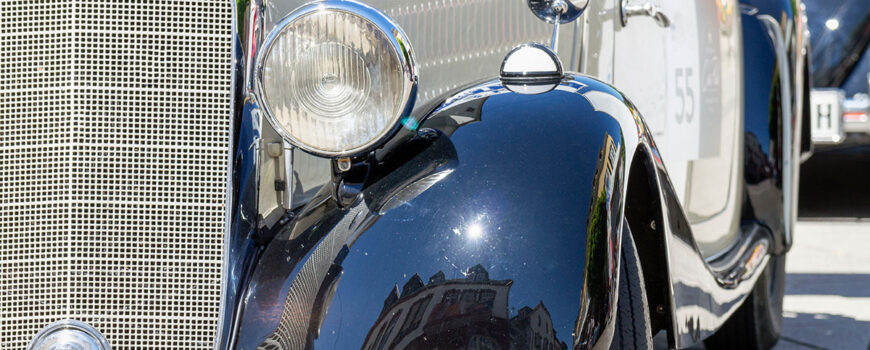The journey of Mercedes-Benz bumpers is a testament to the brand’s commitment to innovation and safety. Over the decades, these bumpers have transformed from simple steel bars to advanced systems that integrate cutting-edge technology. This article explores the evolution of Mercedes bumpers, highlighting key developments and their impact on vehicle design. Read on and discover how these crucial safety components have changed over time.
Foundations (1930s – 1950s)
In the early days, Mercedes focused on creating bumpers that were functional and durable. During the 1930s to 1950s, the use of strong steel bars was standard, providing essential protection against minor impacts.
As the world emerged from World War II, new safety regulations began to shape the design of bumpers, requiring them to be more robust. This era laid the groundwork for future advancements in bumper technology.
Early Steel Bars and Minimal Styling
Initially, Mercedes designed bumpers to focus on strength and protection. The emphasis was on using sturdy steel bars to safeguard the vehicle, with little attention to aesthetics. These bumpers were purely designed to withstand the wear and tear of daily use.
Post-War Safety Regulations Begin
After the war, safety became a priority. Mercedes responded by enhancing bumper designs to meet new safety standards, ensuring better protection for drivers and passengers. This marked the beginning of a shift towards more comprehensive safety features in automotive design.
Safety Takes Centre Stage (1960s – 1970s)
Building upon the foundation of basic protection, the 1960s and 1970s marked a significant shift towards safety in automotive design. Mercedes advocated for passenger safety by introducing bumpers that could absorb energy during collisions. At the same time, the addition of chrome finishes added a touch of luxury, reinforcing the brand’s premium image. This era saw bumpers becoming both safer and more stylish.
Energy-Absorbing Structures Arrive
Mercedes pioneered the use of energy-absorbing bumpers, which played a vital role in reducing the impact of collisions on passengers. These structures were designed to deform in the event of a car accident, absorbing impact and minimising the force felt by the vehicle’s occupants.
Chrome Finish and Brand Identity
The introduction of chrome finishes not only enhanced the visual appeal of Mercedes bumpers but also solidified the brand’s identity as a luxury automaker. The gleaming chrome added a touch of elegance and sophistication to the vehicle’s overall design.
Aerodynamics and Plastic (1980s – 1990s)
As automotive technology advanced, the 1980s and 1990s saw Mercedes embracing new materials and designs. The use of plastic and lightweight composites made for more aerodynamic bumpers, improving fuel efficiency and performance. This transition marked a move towards more efficient and streamlined vehicle designs.
Integrated Air Ducts for Cooling
Bumpers began to feature integrated air ducts, which helped cool the engine and enhance the vehicle’s aerodynamics. These ducts channelled airflow to critical components, preventing overheating and improving performance.
Lightweight Composite Materials
The shift to lightweight materials in bumper design reduced overall vehicle weight, improving fuel efficiency. These materials also offered improved impact resistance and design flexibility.
Tech Integration (2000s – 2010s)
The turn of the century introduced technological integration into bumper design. Mercedes incorporated features like parking sensors and radar modules, enhancing driver assistance and safety systems. This era saw bumpers becoming increasingly intelligent and integrated with the vehicle’s overall technology.
Parking Sensors and Radar Modules
These technological additions encouraged drivers to have greater awareness of their surroundings, making driving safer and more convenient. The sensors and modules helped drivers navigate tight spaces and avoid collisions.
Styling Language: From Elegance to AMG Aggression
During this period, Mercedes evolved its styling language, moving from classic elegance to a more aggressive AMG-inspired design, reflected in the bumper aesthetics. This shift reflected a broader trend in automotive design towards sportier and more dynamic styling.
Current Trends and Future Directions
Today, Mercedes continues to push innovation with advanced technologies and sustainable materials in bumper designs. Active aero flaps and crash-predictive systems are being integrated to enhance performance and safety, reflecting a commitment to both cutting-edge technology and responsible engineering.
Active Aero Flaps and Crash-Predictive Systems
Active aero flaps adjust airflow based on vehicle speed and driving conditions, optimising aerodynamic performance. Crash-predictive systems utilise sensors to anticipate collisions and pre-tension safety systems. This proactive approach to safety is a key area of development.
Recycled Plastics and Easy Repairs
The increased use of recycled plastics, such as recycled polypropylene (PP), in bumper production is a key initiative by Mercedes to reduce environmental impact. These designs are developed to be easier to fix, which not only cuts down on replacement costs but also minimises waste. More people now want cars that are both eco-friendly and affordable to maintain.
Authentic Mercedes Bumper Range for Vintage and Modern Models from Sun Eng Hup
For Mercedes auto enthusiasts in Malaysia, Sun Eng Hup offers a wide range of genuine Mercedes bumper parts for both vintage and modern models. With expertise in European car components, Sun Eng Hup understands the intricacies of Mercedes engineering, ensuring high-quality repairs and replacements. Our skilled technicians know the unique requirements of European vehicles, providing precise and reliable service to keep your Mercedes in top condition. Whether you’re restoring a classic or maintaining a modern vehicle, contact us for assistance with authentic parts and the expert care you need.

